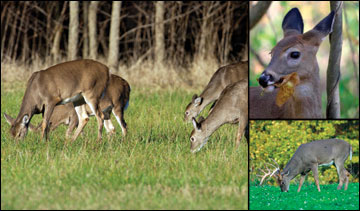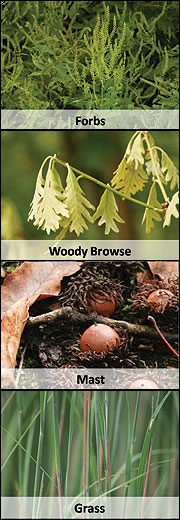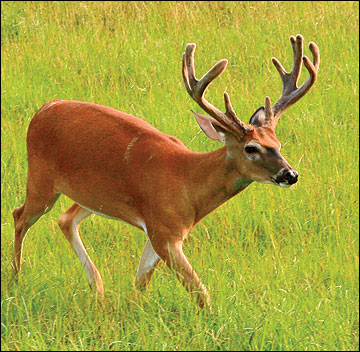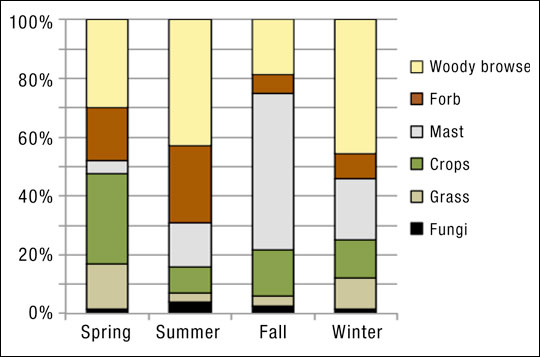Enhancing a habitat to provide a mix of vegetation that will satisfy the nutritional requirements of deer throughout the year is an important factor in managing for a healthy deer population. White-tailed deer rely on a variety of foods for important nutrients that support their physiological functions (Figure 1) and nutritional requirements, which vary with the seasons.
A healthy deer population has the following attributes:
- Higher recruitment rates
- Greater body mass
- Larger antler growth potential
Nutrition is one of three main factors that influence antler growth and body size of white-tailed deer. The other two factors are age and genetics. This guide focuses on the importance of providing nutrition as the basis for managing quality deer populations on a property. For more information on how nutrition, age and genetics affect antler and body size, refer to MU Extension publication G9480, Implementing Quality Deer Management on Your Property.
 Figure 1. The nutritional quality of vegetation is an important factor in ensuring a healthy deer population.
Figure 1. The nutritional quality of vegetation is an important factor in ensuring a healthy deer population.
Understanding deer nutrition
Nutrition can be defined as the process by which an animal sustains its physiological functions through the foods it eats. White-tailed deer eat a variety of plant materials.
Food habit studies have identified more than 600 plant species in the diet of white-tailed deer in Missouri. Studies have also evaluated the specific nutrients found in these forages. Although many variables that influence the nutritional needs of deer are still unknown, research suggests that a deer’s nutritional requirements vary depending on the following variables:
- Sex
Male or female - Age
Fawn, yearling or adult - Physiological state
Producing fawns, growing antlers, body growth, etc. - Weather conditions
Temperature, precipitation, wind, etc.
An animal’s diet can be defined as the specific set of foods it eats on a daily or seasonal basis. A deer’s diet is varied and complex because of the countless variables that influence the amount and types of foods available in an area. Soil quality plays an important role in determining the nutrients available within the vegetation in a particular area. Land-use patterns affect the type of vegetation available. For example, deer that live in habitats that contain large amounts of woodlands, such as southern Missouri, will likely have access to acorns during the fall. Deer in northern Missouri have access to fewer acorns but larger amounts of row crops such as corn, soybeans and wheat. Such regional diet differences make the complexities of how deer select foods at any given time difficult to understand.
Deer nutritional requirements
White-tailed deer are “browsing” animals, which means they eat a variety of forages, including woody browse; forbs, or broad-leaved plants; masts, including hard mast such as acorns and soft mast such as persimmon; and grasses (Figure 2). Deer have food preferences and often select the growing tips of plants to browse, as the tips typically are succulent and the most nutrient-rich portion. A single food item does not dominate a white-tailed deer’s diet during the year because food selection depends on a food’s palatability and availability, and the season. To support a healthy deer population, a habitat must include adequate amounts of diverse foods throughout the year (Table 1).
Nutrients support an animal’s physiological needs. The nutritional requirements of white-tailed deer are relatively similar throughout the deer’s range; however, they change seasonally, as does the nutritional content of the vegetation. These requirements include protein, energy, minerals, vitamins and water.
 Figure 2. Deer eat a variety of plants to fulfill their nutritional requirements.
Figure 2. Deer eat a variety of plants to fulfill their nutritional requirements.
Protein
Protein is needed for normal body maintenance and growth, reproduction, lactation and antler growth. A diet high in protein is required for male deer to produce antlers that reflect their genetic potential (Figure 3).
Studies of pen-raised deer indicate the importance of protein in the diet. Two-year-old male deer fed a diet composed of 8 percent protein produced half the antler mass that was produced by 2-year-old males fed a diet composed of 16 percent protein. By 4 years of age, males consuming an 8 percent protein diet grew antlers that were 20 inches smaller than males consuming a 16 percent protein diet.
Protein requirements change throughout the year and vary depending upon age and sex of individual deer. Table 2 lists the protein requirements of white-tailed deer by age-class and physiological activity. Older deer that are no longer growing in body size need only a 6 to 10 percent protein diet for maintenance (not including reproduction and antler growth). During the winter, deer do not require large quantities of protein. In the spring and summer, however, protein requirements increase for both males and females.
For adult females, protein requirements increase due to pregnancy, particularly in the last trimester. Lactation imposes the greatest protein demand on females, as white-tailed deer milk averages 8.2 percent protein. The quantity and quality of milk will likely decrease in females that don’t get enough protein during lactation. Females that produce twin fawns have an even higher protein requirement (Figure 4).
For adult males, antler growth requires the most protein of all annual physiological activities. Hardened antlers of a white-tailed deer are composed of about 45 percent protein. However, body growth and maintenance take precedence over antler growth; thus, if protein availability is low during the spring and summer, males will tend to produce smaller antlers. In general, a diet of 16 percent protein is optimal for antler development.
 Figure 3. Male deer require more protein in their diet during antler development.
Figure 3. Male deer require more protein in their diet during antler development.
Table 2. Protein requirements of deer by age and physiological activity.
| Age | Activity | Protein level |
|---|---|---|
| Fawn | Average growth | 14 to 18 percent |
| Fawn | Excellent growth | 16 to 20 percent |
| Yearling | Maintenance | 11 percent |
| Adult | Maintenance | 6 to 10 percent |
| Adult (female) | Late pregnancy | 11 to 15 percent |
| Adult (female) | Lactation | 14 to 22 percent |
| Adult (male) | Antler development | 15 to 16 percent |
 Figure 4. Female deer require more protein in their diet during the spring to support pregnancy and lactation. Those that bear twin fawns require even greater amounts of protein.
Figure 4. Female deer require more protein in their diet during the spring to support pregnancy and lactation. Those that bear twin fawns require even greater amounts of protein.
Energy
Although “energy” is generally not classified as a nutrient, the energy levels of deer are a direct result of nutrient levels in the foods eaten. Deer require energy for body maintenance, reproduction, growth and normal daily activities, such as social interactions, predator escape and body temperature regulation. Energy requirements of deer are related to the individual’s body mass; the larger the animal, the greater the energy requirement. Other conditions that affect a deer’s energy requirement include the status of its pelage (coat), physiological activity and weather.
In the fall, deer seek foods with high levels of carbohydrates, which are stored in the body as fat reserves. These fat reserves are a source of energy during the breeding season and periods of winter stress. Acorns and grain crops have high levels of carbohydrates, which is one reason deer are attracted to these foods in the fall.
White-tailed deer also have high energy requirements during the winter. Research has shown that during winter they select foods that are rich in energy over foods high in protein. Energy is needed for body temperature regulation. The high level of stress during the breeding season can cause males to lose up to 30 percent of their body weight, so consuming forages rich in energy is essential for their body condition to recover. In addition, fawns require a high-energy diet during the winter because they tend to have low body reserves and social status, making them susceptible to severe winter conditions.
Female white-tailed deer have high energy requirements during the summer, when they are either about to give birth or have given birth and are lactating. Females spend about 20 percent of the total energy required to produce fawns during pregnancy and the remaining 80 percent during lactation. Peak milk production generally occurs between 10 and 37 days after the birth.
Minerals
Minerals make up about 5 percent of a deer’s body. However, the complete list of specific minerals and amounts required by white-tailed deer is currently unknown. The two most prevalent and studied minerals are calcium (Ca) and phosphorus (P). White-tailed deer need these two minerals for bone and antler growth, milk production and general metabolism.
Eighty to 90 percent of the calcium and phosphorus in a deer’s body is found within its skeletal system. Hardened antlers are composed of about 22 percent calcium and 11 percent phosphorus. Males with diets low in these minerals often have delayed antler growth and velvet shedding. In normal conditions, calcium and phosphorus are available in the soil and vegetation. However, phosphorus is less accessible in acidic soils (low in pH).
Both calcium and phosphorus are required for growth and reproduction. A deer can store these minerals in its skeleton until they are needed, such as for antler growth. Then the deer experiences a form of osteoporosis, or removal of minerals from the skeletal system, an annual occurrence for deer. Once the demand ends, the minerals that were removed from the bones are replaced by nutrients obtained through the deer’s diet.
Sodium, or salt, is another mineral deer require. Deer seek sodium during the spring and summer, often from natural sources found in the soil, such as a salt lick. During this time, the high moisture content in plants can lead to decreased sodium levels. Research has found that females need twice as much sodium as males due to reproduction demands.
Vitamins
Vitamins are important nutrients, but specific amounts needed by deer are not known. Vitamin deficiencies rarely occur and are not considered to be a limiting factor in natural habitats.
Water
Water is a critical nutrient for deer. Water requirements are partially met by moisture within vegetation they eat. Deer also require a surface water source, such as a pond, stream or spring, to provide their water needs, which is believed to be about 3 to 6 quarts per day.
About 70 to 75 percent of a deer’s body weight is composed of water. Deer continually excrete water and must replace it every 24 to 48 hours to maintain health. Research has shown that deer will reduce food intake with a moderate restriction in water.
Seasonal nutritional requirements
The quantity and nutritional quality of forages eaten by white-tailed deer vary seasonally. Figure 5 depicts the protein concentration and availability of selected food items, and Figure 6 shows seasonal changes in a deer’s diet.
Deer nutritional requirements also change with the seasons, primarily because the physiological activities of deer vary by season. For example, the timing and availability of protein and energy found in forages can directly influence antler growth, such as the number of antler points grown by yearling males. Typically, late summer and winter are the most nutritionally stressful times for white-tailed deer in Missouri. These stress periods result from a decrease in food availability coupled with greater energy demands of physiological events such as antler growth, breeding season recovery and lactation.
 Figure 5. Approximate protein concentration and seasonal availability of selected deer browse, mast and forages used in food plots.
Figure 5. Approximate protein concentration and seasonal availability of selected deer browse, mast and forages used in food plots.

Figure 6. The percentage of various food items by season in a deer's diet.
Spring
Nutritionally, spring is the optimal time of the year for white-tailed deer. With spring comes an emergence of new, succulent vegetative growth, which is typically high in protein and other nutrients.
Management practices can be conducted to stimulate and encourage the development of new plant growth. For example, prescribed burning, disking, timber stand improvement (TSI) and timber harvest can stimulate the growth and availability of browse and succulent vegetation that contain high levels of important nutrients. When these practices are conducted during the previous fall and spring, the availability of high-quality forages can be extended into the following summer.
Summer
Annual and perennial forbs and woody browse are the main components of a deer’s diet during the summer. In recently hayed fields, legumes and other forbs are likely to be preferred over grasses, which become less palatable at this time of the year. Deer prefer summer grape, red clover, Virginia creeper, Korean lespedeza and a variety of agricultural crops during the summer. (Table 1 lists foods preferred by white-tailed deer.) Several browse species such as red or white clover and native legumes can reach protein levels of 20 to 24 percent during the summer months, particularly if they are periodically mowed during their active growing stage. However, to decrease the chance of fawn mortality, mowing pastures should be avoided during the peak fawning period (May 15 to July 1). As summer progresses, protein levels in plants tend to decrease, while lignin increases, making vegetation less palatable to deer.
Fall and winter
Many native plants and browse species with a high protein content mature during the spring and summer, becoming less palatable during the fall and winter. At this time of year, soft and hard mast are important food sources for white-tailed deer: persimmons, blackberries and other soft mast fruits are usually available; and hard mast, such as acorns, is a primary food source for deer. Deer will also eat agricultural crops such as corn, soybeans and wheat, if they are available. Other important foods for deer in the fall and winter are clovers, lespedezas and native plants such as sumac, greenbrier and coralberry (buckbrush).
During the fall, antler development and lactation cease, allowing deer to build up their fat reserves for the rigors of the breeding season and winter. Acorns and corn are low in protein but have a high energy content, so they are staple foods in areas where they are available.
Woodlands and forested habitats can be managed to provide important deer forages by encouraging the growth of red and white oaks, opening thick stands of timber through TSI practices, encouraging brushy cover growth and fencing out grazing cattle. To ensure an adequate supply of acorns, it is generally best to maintain a diversity of mature red and white oak tree species. The quantity of acorns produced by an individual tree depends on its crown size, spacing, age and health and the weather. Additional forest management practices that encourage the growth of woody browse include edge feathering, maintaining permanent forest openings, conducting prescribed fire and restoring natural plant communities.
During the winter, deer can also greatly benefit from cool season food plots. Cool season annuals such as oats and winter wheat can provide a source of protein and, when mixed with clovers and other legumes, make these “green-browse” plots attractive to deer at a time when foods containing high levels of protein are generally unavailable. However, food plots are not a replacement for natural food sources on a property, which can be enhanced through habitat management activities.
A variety of management practices can be used on a property to increase the availability of nutritious foods that benefit deer. Figure 7 provides an example of how habitat improvement practices can be implemented to enhance the availability of foods during each season of the year.
 Figure 7. Managing for a diversity of vegetation throughout the year provides deer with high-quality food sources and adequate nutrition. In this example, the landowner has implemented timber stand improvements; managed old fields, pastures and hay fields; and established food plots to achieve management goals and objectives.
Figure 7. Managing for a diversity of vegetation throughout the year provides deer with high-quality food sources and adequate nutrition. In this example, the landowner has implemented timber stand improvements; managed old fields, pastures and hay fields; and established food plots to achieve management goals and objectives.
Importance of managing deer populations
When an area contains more deer than the habitat can support, the quantity and nutritional quality of vegetation will decrease over time. In such a case, the deer population has exceeded the habitat’s biological carrying capacity. This situation can cause long-term damage to the habitat and the deer herd’s health, resulting in a deer population with poor body condition, lower recruitment and small-antlered bucks.
In rural areas, deer hunting is the primary method for regulating populations. Once an acceptable population density is achieved, habitat management practices can be implemented to enhance the availability of food and cover. Maintaining deer populations at a specific level requires herd monitoring. Refer to MU Extension publications G9481, G9482 and G9483 for more information on the collection of camera, harvest and observational information as a basis for deer population management.
Conclusion
To ensure a healthy white-tailed deer population, landowners need to understand and provide for their nutritional needs throughout the year. Although deer nutritional requirements vary by season, age, physiological activity and sex, management practices can be implemented to enhance habitats, providing a diversity of forages. For more information on the ecology and management of white-tailed deer in Missouri, see the related MU Extension publications listed on the next page.
Select references
- Harmel, D.E., J.D. Williams, and W.E. Armstrong. 1989. Effects of genetics and nutrition on antler development and body size of white-tailed deer. Austin, TX: Texas Parks and Wildlife Department.
- Hewitt, D.G. 2011. “Nutrition” in Biology and management of white-tailed deer, ed. D.G. Hewitt, 75 to 105. Boca Raton, FL: CRC Press.
- Kammermeyer, K.E., K.V. Miller, and L. Thomas Jr. 2006. Quality food plots: Your guide to better deer and better deer hunting. Bogart, GA: Quality Deer Management Association.
- Oftedal, O.T. 1985. “Pregnancy and lactation” in Bioenergetics of wild herbivores, eds. R.J. Hudson and R.G. White, 215 to 238. Boca Raton, FL: CRC Press.
- Ullrey, D. E. 1982. “Nutrition and antler development in white-tailed deer” in Antler development in Cervidae, ed. R.D. Brown, 49 to 60. Kingsville, TX: Caesar Kleberg Wildlife Research Institute.
Photo credits
Missouri Department of Conservation and Emily Flinn.